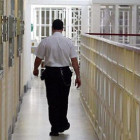
Telestory Unites New York Children — Briefly — with Incarcerated Parents
|
NEW YORK — As the lullaby started, a little boy named Sean listened intently. His mother watched him. She had written and prerecorded the song for him from Rikers Island.
Juvenile Justice Information Exchange (https://jjie.org/tag/incarceration/page/3/)

NEW YORK — As the lullaby started, a little boy named Sean listened intently. His mother watched him. She had written and prerecorded the song for him from Rikers Island.

Each year, thousands of children are subjected to solitary confinement in juvenile facilities and adult jails and prisons. Solitary confinement — also known as room confinement, seclusion, isolation or segregation — is the involuntary placement of a youth alone in a cell, room or other area for any reason.

On the desk of California Gov. Jerry Brown is a key that could unlock the prison gates for inmates sentenced as youth to life without parole. The key comes in the form of legislation, Senate Bill 9, a long-fought proposal to allow such inmates to petition for resentencing after serving 15 years. Inmates are not eligible if the crime involved torture or the killing of officials such as law enforcement officers. To get a chance at parole or a reduced sentence, the offender must convince a judge of their remorse and their progress toward rehabilitation. Advocates say the proposal is a win for children, but opponents say it’s a loss for crime victims.
“The Fair Sentencing for Youth Act [SB 9] ensures youth are held accountable for their crimes in a way that reflects the distinct characteristics of youth, with a focus on rehabilitation and reintegration into society,” said Jody Kent-Lavy, Director and National Coordinator of the national Campaign for the Fair Sentencing of Youth, in a written statement.

Bart Lubow, who has been working for more than 20 years to reduce the number of youth being sent to detention centers, told a gathering of 700 attendees at the Juvenile Detention Alternatives Initiative (JDAI) conference in Houston last week that now, “may prove to be a unique moment in juvenile justice history, a time when, as a nation, we shed some of the system’s worst baggage - including our unnecessary and often inappropriate reliance on secure confinement” of youth. Center for Sustainable Journalism Executive Director Leonard Witt, publisher of the Juvenile Justice Information Exchange and Youth Today, caught up with Lubow to get his take on JDAI initiatives that have expanded to 38 states across the country and become the most widely replicated juvenile justice system reform project in the nation. Learn more about Bart Lubow, Director of Juvenile Justice Strategy for the Annie E. Casey Foundation.

Jeannette Bocanegra, a community organizer from New York City, told a gathering of juvenile justice system practitioners and advocates in Houston last week that as a mom with a child who was incarcerated, “This system made me feel like I was a dysfunctional parent, a bad parent … without realizing I raised six other children who never went into the system.”
Now she and other members of Justice for Families, an advocacy group, are out to prove that, in her words, “We are not dysfunctional … the system is dysfunctional.”
Liane Rozzell, another parent on the panel, said afterwards, “We don’t have 24-hour remote control over our children.”
During the panel discussion, Rozzell said when her son was first put into detention she thought it might be a good thing, it would teach him a lesson. But she did not realize how negatively he would be affected by the experience. She also recalled being in a meeting where a teacher from a correctional institution off handedly mentioned sending kids to “an inherently violent place like a juvenile correctional center.”
After hearing that phrase, Rozzell said, “I was just stunned that we can just casually talk about sending our children to an inherently violent place.”
In June, Justice for Families will be releasing an in-depth report, underwritten by the Annie E. Casey Foundation. The report includes results of a survey of 1,000 family members who have had children incarcerated and examines how families of the incarcerated are portrayed by the media. Justice for Families co-director Grace Bauer says family involvement and networking is necessary because, “No one knows what it is like to struggle with a child in the system better than another parent.”
However, according to Bauer, early findings from the report reveal, “Families are not consulted.

Texas State Senator John Whitmire came to the podium last night at the opening of the Juvenile Detention Alternatives Initiative (JDAI) conference in Houston and got right to the core work of the JDAI. Five years ago, he said, 5,000 youth in Texas were incarcerated at any one time. Today the number is down to 1,500. It has happened, he said, without compromising public safety. The JDAI is an initiative backed by the Annie E. Casey Foundation and according to its press release, “In 2010, JDAI sites detained 42 percent fewer youth — approximately 2,400 — on an average day than they had prior to implementing approaches that include electronic monitoring, community monitoring, and day or evening reporting centers."

NEW YORK – The John Jay College of Criminal Justice’s Center on Media, Crime and Justice is holding a two-day conference for journalists on its campus in New York Monday and Tuesday. While the conference, Kids Behind Bars, Where’s the Justice in America’s Juvenile Justice System?, is primarily meant for journalists, many of the topics will be of interest not only to those in the field, but the general public as well. JJIE/Youth Today’s John Fleming and Clay Duda are attending the conference and continue their reporting today. For Day One coverage head over to our post here. DAY TWO
Panel One:
Mike Bocian, provided the keynote address Tuesday morning.

There is no qualifying the corners of human suffering around the globe. It is all bad, from massacre sites, to famine zones. Still, if you consider just how dark the outlook for a human can be on God’s green Earth, observe the work in West Africa of the Spanish photographer Fernando Moleres. Few places in the world hold the level of hopelessness of an African prison, for the most part vortexes that may release a human but never the human spirit. Now imagine a prison in a failed state in Africa.

Youth in the juvenile justice system are at high-risk for physical, mental and developmental health issues according to a new policy statement by the American Academy of Pediatrics’ Committee on Adolescence. Despite this, many youths don’t receive the level of health care they need, either in the system or when they get out. The report represents the first update in 10 years to the Health Care for Youth in the Juvenile Justice System. Nationwide 2.11 million* juveniles were arrested in 2008, according to the report. And while not all arrested youth are placed in some form of detention (either short- or long-term) the median stay in custody in 2006 was 65 days.

A majority of Americans favor rehabilitation and treatment of youth over incarceration, new national poll found. The survey, commissioned by the Campaign for Youth Justice (CFYJ), also found most Americans, 76 percent, believe youth should not automatically be sent to adult court. The poll was given to 1,000 U.S. adults.
"This public opinion research demonstrates Americans’ strong support for rehabilitation and treatment for court-involved youth, over incarceration and automatic prosecution in adult criminal court," stated CFYJ’s President and CEO Liz Ryan in a press release. "In light of this research, it is urgent that state officials accelerate youth justice reforms to reduce the incarceration of youth and prosecution in adult criminal court, and that Congress and the Administration reject deep cuts to juvenile justice funding."
Other highlights from the poll include:
A large majority of the public, 89 percent, would prefer youth to receive treatment, counseling and education.
Family is an important component in the juvenile justice system. Eighty-six percent of Americans favor involving the youth’s family in treatment while ensuring youth remains connected to their families.
Sixty-nine percent of Americans believe children should not be placed in adult prisons and jails.
Many Americans, 71 percent, favor providing more funds to public defenders to represent youth in court.
Eighty-one percent of Americans trust judges over prosecutors when determining if a child should be tried as an adult.